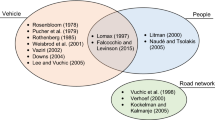Abstract
In this paper, a new model for charging infrastructure placement with latency optimization is presented. Nodal charging latency coefficients are calculated including the traffic flow over a candidate location and charging time of the charging technology to be installed. Faster charging and lower traffic flow reduce charging latency and vice versa. To exceed optimization problem’s complexity, set-cover modeling is applied to model the road network and the electric vehicle driving trajectories comprising the drivers’ behavior. As a result, optimal number and layout of charging locations are found for the minimal charging infrastructure latency, subject to the charging reliability constraint. Numeric results illustrate integration of the charging latency as part of optimal charging infrastructure placement modeling. An optimal locations layout is shown for applying the optimization model to a 10 × 10 discrete grid with driving trajectories. A comparison is made with a reference model that is user-centric and quality of service based to oversee advantages of the newly infrastructure-centric planning model by minimizing charging latency. Differences are found in optimal layouts with the change of optimal locations.






Similar content being viewed by others
References
Jung J, Chow JY, Jayakrishnan R, Park JY (2014) Stochastic dynamic itinerary interception refueling location problem with queue delay for electric taxi charging stations. Transp Res Part C Emerg Technol 40:123–142
Feng W (2021) Spectral analysis of the queueing model for IEEE 802.16 wireless networks. Wirel Pers Commun 121(3):2073–2110
Xiao D, An S, Cai H, Wang J, Cai H (2020) An optimization model for electric vehicle charging infrastructure planning considering queuing behavior with finite queue length. J Energy Storage 29:101317
Davidov S, Pantoš M (2017) Planning of electric vehicle infrastructure based on charging reliability and quality of service. Energy 118:1156–1167
Davidov S, Pantoš M (2019) Optimization model for charging infrastructure planning with electric power system reliability check. Energy 166:886–894
Davidov S, Pantoš M (2017) Stochastic expansion planning of the electric-drive vehicle charging infrastructure. Energy 141:189–201
Davidov S, Pantoš M (2017) Impact of stochastic driving range on the optimal charging infrastructure expansion planning. Energy 141:603–612
Masi DMB, Fischer MJ, Garbin DA (2007) Modeling the performance of low latency queueing for emergency telecommunications. In: 2007 Winter simulation conference, pp 2266–2275. IEEE
Chen H, Abbas R, Cheng P, Shirvanimoghaddam M, Hardjawana W, Bao W, Li Y, Vucetic B (2018) Ultra-reliable low latency cellular networks: use cases, challenges and approaches. IEEE Commun Mag 56(12):119–125
Padmanabhan VN, Mogul JC (1995) Improving HTTP latency. Comput Netw ISDN Syst 28(1–2):25–35
Shih YY, Chung WH, Pang AC, Chiu TC, Wei HY (2016) Enabling low-latency applications in fog-radio access networks. IEEE Netw 31(1):52–58
Al Zishan A, Haji MM, Ardakanian O (2021) Adaptive congestion control for electric vehicle charging in the smart grid. IEEE Trans Smart Grid 12:2439–2449
Petrou K, Quiros-Tortos J, Ochoa LF (2015) Controlling electric vehicle charging points for congestion management of UK LV networks. In: 2015 IEEE power and energy society innovative smart grid technologies conference (ISGT), pp 1–5. IEEE
Caramanis M, Foster JM (2009) Management of electric vehicle charging to mitigate renewable generation intermittency and distribution network congestion. In: Proceedings of the 48h IEEE conference on decision and control (CDC) held jointly with 2009 28th Chinese control conference, pp 4717–4722
Eliasson J, Hultkrantz L, Nerhagen L, Rosqvist LS (2009) The Stockholm congestion–charging trial 2006: overview of effects. Transp Res Part A Policy Pract 43(3):240–250
Tvinnereim E, Haarstad H, Rødeseike A, Bugnion V (2020) Explaining public acceptance of congestion charging: the role of geographical variation in the Bergen case. Case Stud Transp Policy 8(3):992–1001
Baouche F, Billot R, Trigui R, El Faouzi NE (2014) Electric vehicle charging stations allocation model. In: ROADEF-15ème congrès annuel de la Société française de recherche opérationnelle et d’aide à la décision
Chvatal V (1979) A greedy heuristic for the set-covering problem. Math Oper Res 4(3):233–235
Toregas C, Swain R, ReVelle C, Bergman L (1971) The location of emergency service facilities. Oper Res 19(6):1363–1373
Bayram IS, Bayhan S (2020) Location analysis of electric vehicle charging stations for maximum capacity and coverage. In: 2020 IEEE 14th international conference on compatibility, power electronics and power engineering (CPE-POWERENG), vol 1, pp 409–414. IEEE
Sun Z, Gao W, Li B, Wang L (2020) Locating charging stations for electric vehicles. Transp Policy 98:48–54
Kmetec M, Knez M (2022) Electric vehicle charging stations coverage: a study of Slovenia. Tehnički vjesnik 29(1):285–292
Daskin MS (2011) Network and discrete location: models, algorithms, and applications. Wiley
Danielsson PE (1980) Euclidean distance mapping. Comput Graph Image Process 14(3):227–248
Author information
Authors and Affiliations
Corresponding author
Additional information
Publisher's Note
Springer Nature remains neutral with regard to jurisdictional claims in published maps and institutional affiliations.
Rights and permissions
Springer Nature or its licensor (e.g. a society or other partner) holds exclusive rights to this article under a publishing agreement with the author(s) or other rightsholder(s); author self-archiving of the accepted manuscript version of this article is solely governed by the terms of such publishing agreement and applicable law.
About this article
Cite this article
Davidov, S., Pantoš, M. Charging infrastructure latency optimization. Electr Eng 105, 719–731 (2023). https://doi.org/10.1007/s00202-022-01693-3
Received:
Accepted:
Published:
Issue Date:
DOI: https://doi.org/10.1007/s00202-022-01693-3




